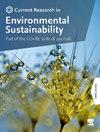Potential environmental benefits of enforcing best available technology in the Swedish dairy cattle systems
IF 3.8
Q2 ENVIRONMENTAL SCIENCES
Current Research in Environmental Sustainability
Pub Date : 2025-01-01
DOI:10.1016/j.crsust.2025.100306
引用次数: 0
Abstract
Animal-based food production places significant strain on environmental resources, yet much of its mitigation potential remains untapped. Sweden's Environmental Code (1999) mandates resource efficiency and waste minimization, but its application to reduce on-farm losses in agriculture has not been fully explored. This study examines the potential environmental impact of targeting animal losses through the enforcement of the Environmental Code on Swedish cattle farms.
Using data from 4222 dairy cattle farms, we demonstrate that reducing losses on farms exceeding the median loss rate could lead to 2800 t of additional meat reaching the food supply chain annually (34 % reduction in losses), decrease the CO2e associated with meat losses by 52,000 t, and recover €15 million in revenue losses. While these reductions represent a small fraction of Sweden's total agricultural emissions, the study suggests the potential could be even greater if applied to all livestock farms nationwide.
Importantly, Sweden's Environmental Code aligns with EU legislation, making these findings highly relevant not only for Sweden but also for other EU countries with similar regulatory frameworks.

在瑞典奶牛系统中实施最佳可用技术的潜在环境效益
以动物为基础的粮食生产对环境资源造成了巨大压力,但其缓解潜力仍未得到充分开发。瑞典的环境法(1999年)要求提高资源效率和减少浪费,但其在减少农业农场损失方面的应用尚未得到充分探索。本研究考察了通过对瑞典养牛场实施《环境法》来锁定动物损失的潜在环境影响。利用来自4222个奶牛养殖场的数据,我们证明,减少超过损失率中位数的养殖场的损失,每年可使2800吨额外的肉类进入食品供应链(损失减少34%),减少与肉类损失相关的二氧化碳排放量52,000吨,并挽回1500万欧元的收入损失。虽然这些减少只占瑞典农业总排放量的一小部分,但研究表明,如果将其应用于全国所有畜牧业,其潜力可能会更大。重要的是,瑞典的《环境法》与欧盟立法保持一致,这使得这些发现不仅对瑞典具有高度相关性,而且对其他具有类似监管框架的欧盟国家也具有高度相关性。
本文章由计算机程序翻译,如有差异,请以英文原文为准。
求助全文
约1分钟内获得全文
求助全文
来源期刊

Current Research in Environmental Sustainability
Environmental Science-General Environmental Science
CiteScore
7.50
自引率
9.10%
发文量
76
审稿时长
95 days
 求助内容:
求助内容: 应助结果提醒方式:
应助结果提醒方式:


